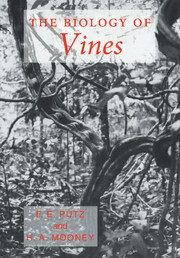Book contents
- Frontmatter
- Contents
- List of contributors
- Foreword
- Preface
- Acknowledgements
- I INTRODUCTION
- II CLIMBING MECHANICS AND STEM FORM
- III VINE PHYSIOLOGY AND DEVELOPMENT
- IV COMMUNITY ECOLOGY OF VINES
- 11 Distribution and abundance of vines in forest communities
- 12 Vines in arid and semi-arid ecosystems
- 13 Vine–host interactions
- 14 Seasonality of climbers: a review and example from Costa Rican dry forest
- 15 Breeding and dispersal systems of lianas
- V ECONOMIC IMPORTANCE OF VINES
- Taxonomic index
- General index
14 - Seasonality of climbers: a review and example from Costa Rican dry forest
Published online by Cambridge University Press: 05 November 2011
- Frontmatter
- Contents
- List of contributors
- Foreword
- Preface
- Acknowledgements
- I INTRODUCTION
- II CLIMBING MECHANICS AND STEM FORM
- III VINE PHYSIOLOGY AND DEVELOPMENT
- IV COMMUNITY ECOLOGY OF VINES
- 11 Distribution and abundance of vines in forest communities
- 12 Vines in arid and semi-arid ecosystems
- 13 Vine–host interactions
- 14 Seasonality of climbers: a review and example from Costa Rican dry forest
- 15 Breeding and dispersal systems of lianas
- V ECONOMIC IMPORTANCE OF VINES
- Taxonomic index
- General index
Summary
Introduction
Conducting a study of the seasonality of flowering, fruiting, and foliation, often termed a phenological study, of species within a plant community is often not an end in itself. It may serve as a way to discover the component species of the community and when each species may be expected to be in a reproductive or vegetative stage suitable for study.
Knowledge of the seasonality of reproductive and vegetative activities by the species in a community is fundamental to other questions. How do the plants respond to environmental variables, notably the climate? Are the phenological patterns of some species affected by competition between plant species for pollinating or dispersal agents? Does foliation occur in such a way as to minimize herbivory? Are the flowering and fruiting of plants with particular pollinatory or dispersal strategies limited to particular seasons? Alternatively, the zoologist may wish to know the seasonal availability of nectar, fruit, or leaf resources for particular animals.
Our approach in this chapter is to emphasize the phenological patterns of reproduction and foliation by many locally sympatric climbers, with a review of the literature and from our own field work in northwestern Costa Rica. We also consider phenological studies of plants (climbers and others), that are adapted for certain groups of pollinators or frugivores.
Community studies
In addition to our work there have been only three other studies on the phenology of climber communities: those by Croat (240 species: 1975) and Putz & Windsor (43 species: 1987), both on Barro Colorado Island, Panama; and that of Hegarty (1988) on the climbers of a Queensland rainforest.
- Type
- Chapter
- Information
- The Biology of Vines , pp. 377 - 392Publisher: Cambridge University PressPrint publication year: 1992



